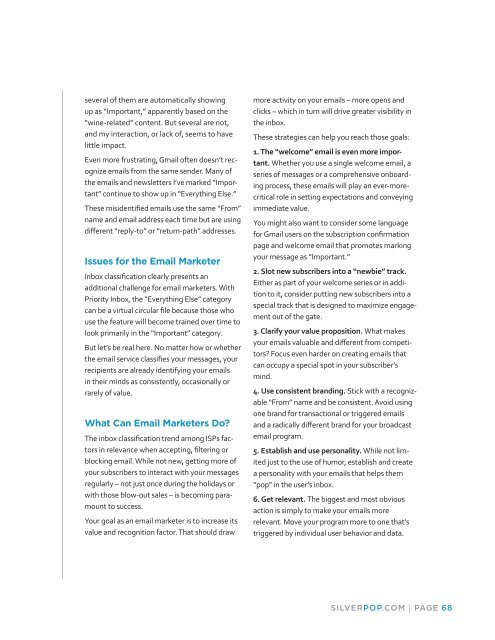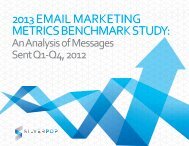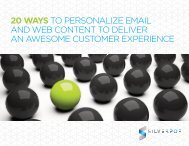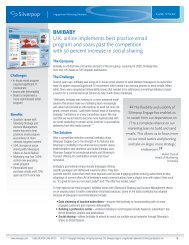eBook - Silverpop
eBook - Silverpop
eBook - Silverpop
You also want an ePaper? Increase the reach of your titles
YUMPU automatically turns print PDFs into web optimized ePapers that Google loves.
several of them are automatically showing<br />
up as “Important,” apparently based on the<br />
“wine-related” content. But several are not,<br />
and my interaction, or lack of, seems to have<br />
little impact.<br />
Even more frustrating, Gmail often doesn’t recognize<br />
emails from the same sender. Many of<br />
the emails and newsletters I’ve marked “Important”<br />
continue to show up in “Everything Else.”<br />
These misidentified emails use the same “From”<br />
name and email address each time but are using<br />
different “reply-to” or “return-path” addresses.<br />
Issues for the Email Marketer<br />
Inbox classification clearly presents an<br />
additional challenge for email marketers. With<br />
Priority Inbox, the “Everything Else” category<br />
can be a virtual circular file because those who<br />
use the feature will become trained over time to<br />
look primarily in the “Important” category.<br />
But let’s be real here. No matter how or whether<br />
the email service classifies your messages, your<br />
recipients are already identifying your emails<br />
in their minds as consistently, occasionally or<br />
rarely of value.<br />
What Can Email Marketers Do?<br />
The inbox classification trend among ISPs factors<br />
in relevance when accepting, filtering or<br />
blocking email. While not new, getting more of<br />
your subscribers to interact with your messages<br />
regularly – not just once during the holidays or<br />
with those blow-out sales – is becoming paramount<br />
to success.<br />
Your goal as an email marketer is to increase its<br />
value and recognition factor. That should draw<br />
more activity on your emails – more opens and<br />
clicks – which in turn will drive greater visibility in<br />
the inbox.<br />
These strategies can help you reach those goals:<br />
1. The “welcome” email is even more important.<br />
Whether you use a single welcome email, a<br />
series of messages or a comprehensive onboarding<br />
process, these emails will play an ever-morecritical<br />
role in setting expectations and conveying<br />
immediate value.<br />
You might also want to consider some language<br />
for Gmail users on the subscription confirmation<br />
page and welcome email that promotes marking<br />
your message as “Important.”<br />
2. Slot new subscribers into a “newbie” track.<br />
Either as part of your welcome series or in addition<br />
to it, consider putting new subscribers into a<br />
special track that is designed to maximize engagement<br />
out of the gate.<br />
3. Clarify your value proposition. What makes<br />
your emails valuable and different from competitors?<br />
Focus even harder on creating emails that<br />
can occupy a special spot in your subscriber’s<br />
mind.<br />
4. Use consistent branding. Stick with a recognizable<br />
“From” name and be consistent. Avoid using<br />
one brand for transactional or triggered emails<br />
and a radically different brand for your broadcast<br />
email program.<br />
5. Establish and use personality. While not limited<br />
just to the use of humor, establish and create<br />
a personality with your emails that helps them<br />
“pop” in the user’s inbox.<br />
6. Get relevant. The biggest and most obvious<br />
action is simply to make your emails more<br />
relevant. Move your program more to one that’s<br />
triggered by individual user behavior and data.<br />
SILVERPOP.COM | PAGE 68







